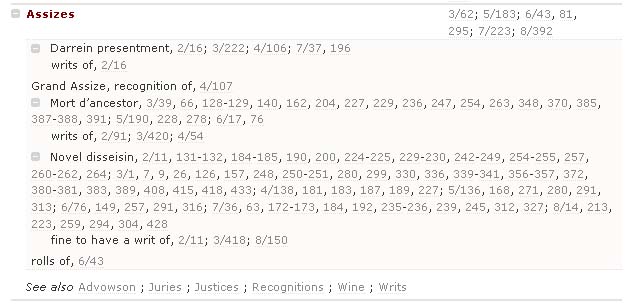Indexes
Document Contents
1. Indexes
Users will find indexes of the Fine Rolls:
When viewing an index of – for example – persons’ names, clicking on a particular entry number from the list of occurrences will take you to the full text of the relevant entry in the specific roll.
For details of the editing process behind the indexes, see Editing the Fine Rolls: Indexing.
2. The Index of Persons
Persons are listed in the index of persons in alphabetical sequence by surname (and by Christian name, when two or more individuals have the same surname), expect for members of the royal family (kings, queens, and their children) who are listed under their Christian names.
2.1. Institutions
Archbishops and bishops are indexed under their surnames in the persons index and with a cross-reference from their sees in the places index.
Heads of religious houses and other religious institutions are indexed under their institutions in the persons index.
2.2. Surnames
Surnames can take the form of:
- general surnames (e.g. Red, Hugh)
- toponymic surnames (e.g. London, Bartholomew of)
- patronyms or other types of relation’s surnames (e.g. Geoffrey, Susanna daughter of)
Variant spellings of non-toponymic surnames are displayed within round brackets after each person heading.
-

-
Examples of variant spellings of non-toponymic surnames for 'Cook' and 'Coombe'.
Individuals with the same name are distinguished, where possible, by the county in which they appear in the rolls or a year (floruit) during which it is known they operated or died.
2.3. Jews
Jews are grouped together under the heading “Jews” rather than being indexed under their individual surnames.
2.4. Entry numbers
On the right end side column next to each name heading the entry numbers are listed, preceded by the regnal year of the relevant roll.
2.5. Roles and Relationships
Each entry can be expanded by clicking on the plus box ![]() to the left- hand side of the index entry (when present). This will
bring up information on:
to the left- hand side of the index entry (when present). This will
bring up information on:
- roles (occupation or specific administrative or judicial position) in alphabetical order and followed by the relevant entry numbers in the rolls
- relationships (blood and/or marital) in the order in which they occur in the rolls and followed by the relevant entry numbers in the rolls
- Writs (references to writs attested by, authorized by, or attested in the presence of, the individual concerned)
-

-
Example of expanded entry including 'roles' and 'writs authorised by' for 'Ralph Hareng'.
-

-
Example of expanded entry including 'relationships' for 'Williams de Burdeleys'.
3. The Index of Places
Every authority that has been identified as a place is listed in the index of places in alphabetical sequence by its modern form.
Variant spellings as well as scribal spellings found in the Fine Rolls are rendered in round brackets. The medieval county (England), province (Ireland) or département (France) in which the place was situated is rendered in square brackets
-

-
Different spellings for ‘Abingdon’ in round brackets and county in square brackets.
-

-
Different spelling for ‘Abbeville’ in round brackets and French département in square brackets.
-

-
Different spelling for ‘Slievardagh’ in round brackets and Irish province in square brackets.
3.1. Unidentified, lost and identifiable places
Unidentified and lost places are indicated as such in the index, while possible identifications are expressed with a question mark.
-

-
Example of unidentified place.
-

-
Example of unidentified place followed by possible location.
-

-
Example of lost place followed by possible location.
3.2. Entry numbers
Entry numbers are listed on the right end side column next to each name heading, and are preceded by the regnal year of the relevant roll.
3.3. Subdivisions
Each entry can be expanded by clicking on the plus box ![]() to the left- hand side of the index entry (when present). An expanded
entry contains the list of the things with which a place is associated (i.e. barton,
borough, bridge, castle, chase, exchange, forest, gaol, manor, market and fair, marshes,
street, suburbs, vill, villate) as given in the rolls and their corresponding entry
numbers.
to the left- hand side of the index entry (when present). An expanded
entry contains the list of the things with which a place is associated (i.e. barton,
borough, bridge, castle, chase, exchange, forest, gaol, manor, market and fair, marshes,
street, suburbs, vill, villate) as given in the rolls and their corresponding entry
numbers.
-

-
Expanded places within the city of York with the corresponding entry numbers in the rolls.
-

-
Expanded places and associated roles (constables) within 'Marlborough' with the corresponding entry numbers in the rolls and cross-references to the index of persons.
4. The Index of Subjects
All the subjects identified by the editors are listed here in alphabetical sequence.
4.1. Entry numbers
The entry numbers are listed to the right of each name heading, and are preceded by the regnal year of the relevant roll.
4.2. Cross-references: See and See also
Cross-references of the type See also link subjects that deal with associated themes in the Fine Rolls. Cross-references of the type See are an attempt to direct the user to the alternative name/s of the same concept as listed in the index.
-

-
Redirection from 'Oxen' to the subject 'Cattle' trough 'See'.
4.3. Hierarchy
By clicking on the box ![]() on the left hand
side of an entry, one can call up references to subsections within the subject.
on the left hand
side of an entry, one can call up references to subsections within the subject.
-

-
Expanded hiararchy of subjects under 'Assizes' and cross-references to associated themes trough 'See also'.